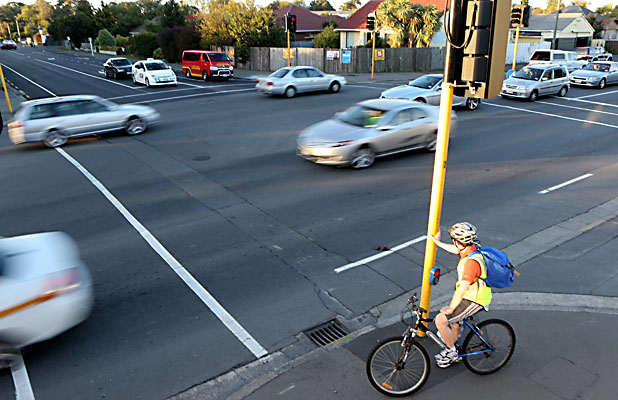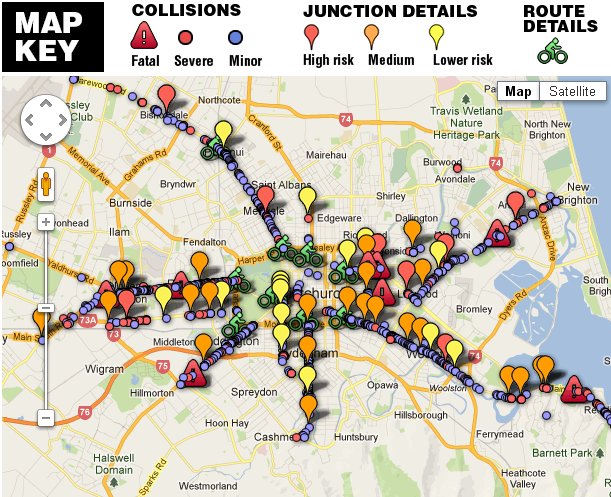Before the cycleway programme started getting rolled out in Chch, the local media didn’t really help things by regularly coming up with various “cycle safety” angles for news items. This article, originally from Apr 2013, is a case in point where some slightly flawed logic leads to some not very helpful conclusions…
Hot on the heels of the recent cycling fatalities in Christchurch, and with the potential for massive new investment in cycleways in Christchurch, The Press has come up with an “interesting” article looking at where the “riskiest” intersections for cycling are around the city.

In principle their approach makes sense: first they obtained reported cycle crash data from 1990 to the present day throughout the city. They also obtained cycle count data from Chch City Council for each intersection that was available. By determining the ratio of crashes to cyclists at each site, they were then able to rank different sites in terms of risk. From this, they determined that the top 3 in terms of risk were: Blenheim/Hansons, Papanui/St.Albans, and Harewood/Johns/Russley.

There’s one big methodological flaw with this exercise in terms of its present-day value: it is looking at crash data over 23 years. That is a very long time to use for assessing cycling safety (by comparison, most road safety studies use no more than 5 years, 10 at most). Cycle patterns and traffic patterns will no doubt have changed over that time; particularly in the last two years since the earthquakes. The sites themselves will also have changed; it may be precisely because they had a bad cycle safety record that many might have been upgraded. When I look at the “high/medium risk” sites on the map, about three-quarters have had some kind of cycle-friendly treatment done to them in the past 20 years (e.g. cycle lanes).
Another thing that this assessment won’t show is evidence of risk mitigation or “danger reduction”, where some people may avoid a particular location because they deem it too risky (multi-lane roundabouts are a common example). Because not many people use it, there aren’t many crashes and so it might fly under the radar. And yet, many people might like to go that way if the option was a bit friendlier for them.
The other thing The Press totally misses (again…) is a bit of context. Let’s have a look at the “riskiest” site, Blenheim/Hansons. In 23 years it had 6 cycle crashes (2 severe, 4 minor). Over that same period, from the cycle count data I also have (which only captures peak hour periods, so needs to be scaled up for all-day counts), conservatively at least 300 riders a day have used that intersection (possibly 400-500). 300 a day over 23 years translates into 2.5 million cycling trips. So that’s one cycle crash for every… 400,000+ riders going through the intersection. Even if you allowed for some under-reporting, they still sound like pretty good odds to me.
This is not to say that there aren’t intersections around that couldn’t benefit from some improvement from a cycling perspective. But, by plastering most of page 2 of Saturday’s Press with a big article and graphic about the city’s “riskiest” sites for cycling, the newspaper have probably only succeeded in once more putting a few more people off riding, because of a misperception about the true safety of cycling. As alluded to in an earlier post, even without new cycleways to help us, the truth is very different.
What’s your “riskiest” intersection in the city to ride through?


The riskiest intersections are the ones where you’re depending on the drivers to do everything right. This is harder at the intersections which are a bit unusual.
* Sockburn Roundabout – I ride the footpath here.
* Ferry Road roundabout – take the lane
* Cranmer and Latimer Square “wiggles” at each end. – take the lane, keep an eye open behind
* Halswell Junction/Springs Road roundabout – even using the bike “paths” you have to be alert
Thing is, I tend to think of roads that are not-good, more than intersections.
* Hornby shops
* Riccarton Road shopping area
* Pound road
* Old Waimak bridge
And some are worst at night.
* Waterloo Road (dark)
* Jones Road (dark)
This dated well – three of my top picks were roundabouts, and just recently I got wiped out at a tiny residential roundabout in Rolleston, by a car not giving way.
Root cause was that classic set of
* Car not stopping completely (why, its a give way not a stop)
* Fat A-pillar on that model of car (airbags are more important than visibility?)
* and my motion through the intersection kept me in the driver’s blind spot the whole way.
A 6-foot flagpole, blinking daytime running lights, high vis clothing, and an unusual bike were all nothing because I was occulted by the car’s structure and unfortunate timing.
So, as an update, I would say that all roundabouts are purely for cars and not for bikes.
I can not think of any good cycling infrastructure that involves a roundabout.